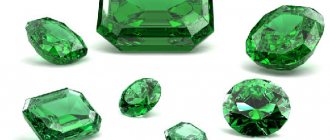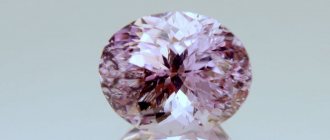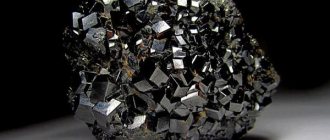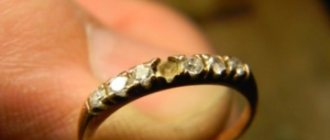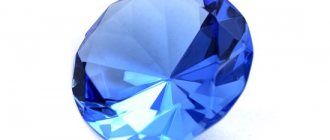Rare stones are in high demand among jewelers and jewelry lovers. The value of the samples is due not only to the small number of deposits, but also to their unique beauty and useful properties.
Chrysoberyl fully meets the described characteristics. The gem fascinates with its appearance, and the inhabitants of Ancient India knew about its magical abilities.
| Opening year: | It was known back in the 1st century AD. |
| Title in English: | Chrysoberyl |
| Category: | Precious |
| Group of stones: | Chrysoberyl group |
| Chemical formula: | BeAl2O4 |
| Color: | Shades of yellow, green in combination, colorless |
| Transparency: | Transparent, translucent |
| Shine: | Glass or diamond |
| Syngony: | Rhombic |
| Hardness: | 8.5 on the Mohs scale |
| Density: | 3.5–3.84 g/cm³ |
| Cleavage: | Perfect, imperfect, weak |
| Kink: | Conchoidal, uneven |
| Morphology: | Diamond crystals |
| Stone price: | The price per carat may exceed the cost of the diamond, depending on the variety and quality |
| Zodiac sign: | Cancer, Gemini |
| Similar stones: | Artificial samples |
Description and meaning
Chrysoberyl has not gained wide popularity, unlike its varieties, known to everyone - cymophane (in other words, cat's eye) and alexandrite.
The mineral is classified as a transparent or semi-transparent gemstone. Most often, the stone forms flattened crystals or twins and tees of germination.
Exactly matching the chemical composition, chrysoberyl is colorless and pure. It has not gained much popularity because it cannot compete with diamond and zircon.
A variety called “cat’s eye”, which has a unique refraction of light, is of great value. The stone is of great importance.
It represents the joy of life, light and mystery. A person wearing a product with a stone feels a pulsation of energy and a thirst for life inside.
Description of the stone
Chrysoberyl is a stone that is considered a precious gem of the first order. Despite the fact that deposits are scattered throughout the world, the rock is mined in small quantities. This explains the high price of some of its varieties.
The mineral is a compound of beryl and aluminum oxides. The composition contains a number of other substances, depending on which the stones acquire different colors and optical effects.
Interestingly, chrysoberyl nuggets can look completely different. There are both transparent and opaque specimens of different shades.
The mineral is very hard. This complicates its cutting and explains the need for diamond grinding.
View this post on Instagram
Post by Artyom Yeskin ⛏⚠️ (@kamneved) Feb 27, 2021 at 2:07 PST
Colors and types of mineral
Chrysoberyl has a fairly wide color palette. The following shades are found in the mines:
- golden;
- bluish green;
- green;
- brown-green;
- scarlet;
- violet;
- light brown;
- transparent;
- grey.
Gems are classified based on the optical effects they have:
- Alexandrite. The rarest, most expensive type of chrysoberyl. Under different lighting, the stone is able to change color, usually from dark green to purple.
- Tsimofan. Opaque or translucent specimens. Gems with a vertical highlight are often found. These are the stones that are called cat's eyes.
- Simple chrysoberyls. Absolutely transparent gems, which, thanks to their glass shine and rich color palette, look attractive.
There are gems interspersed in the form of unusual patterns. They are also prized by jewelers.
Origin story
Four thousand years ago, chrysoberyl and its varieties were first mentioned in an ancient Indian book on medicine. The name comes from the Greek word “chrysos”, which means “golden”. Under natural conditions, the mineral is rarely found.
Perhaps for this reason, geologist A. Werner discovered it only in 1789, and a description of the mineral appeared in 1790. The authors focused on the physical properties of chrysoberyl, which ceased to be a mystery after serious research.
Natural and cut stones are exhibited in many museums and private collections. The most famous is chrysoberyl weighing forty-five carats. It is kept in the British Museum of Natural History.
The former owner of the greenish-yellow gem with a brilliant tint was Henry Hope. The chrysoberyl got its name “Hope” from the surname of the owner of the chrysoberyls.
History of chrysoberyl
— Advertising —
The name chrysoberyl refers to its golden color: from the Greek word “chrysos” is translated as “golden”. Although for this gem there are both colorless specimens and dark, golden brown ones.
As for the official discovery and description of the mineral, this issue remains controversial. According to popular belief, the discoverer of chrysoberyl is A.G. Werner, who found and described it at the end of the 18th century in Brazil. According to other sources, the stone was first discovered in the Urals. But it is known that the magical properties of this gem were used by yogis in ancient times, as evidenced by rock paintings that date back to the 2nd century. BC e.
Physical properties
The following physical properties of chrysoberyl are described:
- The mineral has an uneven or conchoidal fracture.
- In terms of hardness, it is second only to diamond and corundum, having a Mohs scale rating of 8.5 (can cut glass).
- Density – 3.5 – 3.84 g/cm3.
- Rhombic syngony.
- According to the degree of transparency - completely transparent or half transparent.
- The color of the line is white.
- The largest crystal size is 6 cm.
- The crystal structure of the stone resembles olivine.
- Chemical composition: alumina, beryllium oxide, impurities: iron or chromium oxide.
Other Applications
The unique chemical composition, high physical hardness and rich color palette of chrysoberyl make it a very attractive material for use in the jewelry industry. The most popular varieties are warm yellow shades.
But transparent varieties, with the exception of alexandrite, have very little light refraction, so they can appear dull and rather inconspicuous in comparison with diamonds and sapphires. Only alexandrite, after cutting, can look quite sophisticated in any piece of jewelry.
Despite this, crystals with a clear color range are very valuable and expensive collection material.
Field
The mineral belongs to precious stones that are found only in extensive deposits.
Chrysoberyl is mined from limestone and dolomite rocks. This is explained by the fact that it develops in conditions of low silicic acid and high alumina content.
Basically, the stone is found in mica schists and granite in the form of small inclusions.
Sometimes chrysoberyl grows into the voids of other stones. The mineral is mined in Ceylon, Madagascar, Brazil, the United States of America and the Ural emerald mines.
Cat's eye can be found in deposits in Brazil, China, India, Zimbabwe and Sri Lanka, while alexandrite is found in Russia, Madagascar and Tanzania.
Field and production
This is a rare mineral. Most often it is found in granite rocks in the form of inclusions or growths that form in the cavities of other stones. The mines located in Brazil are famous for their deposits . Crystals have been mined here for a long time.
Development is also underway in the American Colorado, on the island of Ceylon and Burma. In Russia, the mineral is mined in the Urals. The deposits are named: “Emerald Mines” and “Malyshevskoye”.
Colors and types
The colors of chrysoberyl are varied: golden, greenish, scarlet, light brown, gray, purple. The color contains variations of green with a bluish tint and brown with a green tint. There are also colorless minerals.
Chrysoberyl is a beryllium aluminum oxide. Some products contain impurities of chromium and iron oxide, which affects the color of the stone. The mineral acquires its green-yellowish color due to iron, and all shades of pure green appear due to the admixture of chromium.
In some cases, chrysoberyl contains titanium. In ancient times, cymophane was very popular due to its properties that give the “cat’s eye” effect. The appearance of the cat's eye effect becomes possible thanks to the unusual structure of the stone, which is given the appearance of a cabochon.
Alexandrite is strikingly different in appearance from other varieties. It has an amazing chameleon property: it changes its color depending on the lighting. The stones found in the Ural deposit are colored greenish-blue, while the specimens from Sri Lanka are bright olive green.
How not to buy a fake
When purchasing a product with a gem, you want to be sure that such jewelry is actually decorated with natural stone and not a synthetic analogue. Chrysoberyl is counterfeited quite often, and in the laboratory, after fusing boric acid, beryllium oxide, aluminum and calcium carbonate, an almost completely identical specimen is obtained. Not only the mineral, but even the documents for it are often counterfeited, so when purchasing, it is important to know by what criteria you can distinguish a real gem from a fake.
Differences between real stones
When looking at stones, it is important to remember that real specimens have unique colors and, in most cases, are surprisingly translucent. It is worth paying attention to the price, because a precious mineral cannot be cheap.
Alexandrite is characterized by a red-green color. It is not so common among other types of mineral, so its price is the highest. The product on offer needs to be viewed under different lighting. The edges will change their shades, ranging from green in daylight to deep cherry under lamplight.
Tsimofan reveals all its beauty when cut as a cabochon. Then the silvery stripe is best visible, for which the mineral is valued. Inside, such a stone contains hollow tubules of a microscopic shade, thanks to which light is reflected, creating the effect of constant movement. A stone with a cat's eye effect looks especially beautiful in pendants and rings. The peculiarity of such a mineral is that it is simply impossible to find two completely identical stones in nature.
What makes synthetic stones different?
To see that the seller is offering not a real, but an artificial stone, it is important to look very carefully at each facet. It is worth remembering that artificially created minerals simply do not have any defects, they are simply perfect, and this should not be the case.
If you carefully examine the artificial analogue, you will see that its color is distributed very unevenly. Alexandrites are often imitated, passing off as artificial stone coated with vanadium. It is worth knowing that the edges of a mineral created in the laboratory can be damaged by ordinary glass. Natural stone is not susceptible to scratches; glass or other material cannot leave marks.
Of course, one of the key points remains price. A quality product simply cannot be cheap.
Magic properties
The magical properties of chrysoberyl have been known for a long time.
Even ancient people used the stone as an amulet, which helps a person find a common language with animals and birds.
The mineral enlightens the mind and increases the level of intelligence, so there is an opinion that it helps in career growth and brings the owner to wide fame.
It is recommended for people who have not yet found their other half to acquire chrysoberyl.
It will help you make the right choice, strengthen family ties and family ties.
People who lived during the Old World believed that a large chrysoberyl ring helped men attract the interest of women. Modern magicians recommend purchasing rings made of gold with a mineral.
Such decoration contributes to great success in many matters. According to ancient beliefs, it is believed that chrysoberyl helps to find peace of mind and tranquility. Magicians make amulets from gemstones that save the owner from black witchcraft, the evil eye and damage.
Therapeutic effects on humans
Old Russian literature, in particular “Svyatoslav’s Illustration,” repeatedly mentions that chrysoberyl was used by folk healers. With the help of the stone, they successfully coped with many diseases.
Modern lithotherapists have applied the experience of their predecessors. They treat diseases such as:
- Poisoning by poisons, including alcoholic beverages.
- Scabies, leprosy, psoriasis.
- Nervous system disorders.
- Diseases of the blood and circulatory system.
- Respiratory diseases.
- Impotence.
In addition, the stone will help cope with sleep disorders, calm and relieve anxiety, and teach you to cope with emotions. Chrysoberyl has been proven to help people with mental illness. They become less excitable and do not experience hallucinations. It is enough to keep a piece of raw mineral in the patient’s room.
Healing properties by color
Violet minerals help a person quickly recover from a concussion.
Yellow-golden varieties of the mineral normalize cholesterol and adrenaline levels in the blood, have a beneficial effect on the kidneys, liver, pancreas, spleen and lymph nodes.
Looking at a gem for a long time benefits the nervous system and vision.
Emerald garnet alexandrite symbolizes arterial and venous blood due to its shade. It helps with anemia, varicose veins and normalizes blood pressure.
Chrysoberyl helps to recover from depression, get rid of insomnia and nightmares.
There is a popular belief that it relieves pain in women and helps cure gynecological diseases. There are cases in history when the mineral helped in the treatment of leukemia.
The energy of the gem helps the functioning of the cardiovascular and nervous systems. With the help of chrysoberyl, they try to cure infertility, diseases of the throat and eyes, cholelithiasis and inflammatory processes.
Properties and uses of chrysoberyl
Chrysoberyl is used exclusively in the jewelry industry. Due to their high cost, gems cannot be found at crafts fairs.
Traditional healers and psychics use the stone for their own purposes. They believe that the mineral has strong energy that can heal diseases and change fate.
Physicochemical characteristics
Chrysoberyl is a beryl aluminate. Its chemical formula is BeAl2O4. The composition of the stone may include iron (yellow shades), chromium (green gems), titanium and some other substances. Transparent specimens do not contain other substances.
The stones have a rich glass or diamond luster. Some gems have an alexandrite effect or cat's eye properties.
There are transparent, opaque and translucent specimens. The crystal lattice has a diamond shape. The fracture is conchoidal, uneven, and has a greasy tint.
The hardness of the stone is 8.5 points. Quite fragile, has no features. Its density is equal to 3.5–3.8 g per cubic meter. cm.
View this post on Instagram
Publication from ғɪɴᴇ ɢᴇᴍs / gems (@gemlovers.ru) Dec 19, 2021 at 4:56 PST
Medicinal properties
The healing effect of the mineral largely depends on the shade:
- Purple stones improve brain activity. Accelerate recovery and tissue healing. Especially useful for concussions.
- Yellow and golden gems lower blood cholesterol and normalize adrenaline levels. Minerals improve the condition of the liver, kidneys, pancreas and spleen.
- Alexandrite improves the functioning of the heart and blood vessels, stabilizes blood pressure.
General properties for all shades of chrysoberyl:
- facilitates the birth process;
- treats female and male infertility;
- promotes restoration of strength;
- helps to bear a healthy child;
- normalizes the psycho-emotional state;
- activates the immune system;
- improves vision.
Magical properties of chrysoberyl and zodiac signs
Since ancient times, people believed that with the help of chrysoberyl one could learn to understand the language of animals.
Businessmen and goal-oriented people love the stone. It helps to establish contacts with partners, climb the career ladder, and makes any endeavor successful. This stone does not attract luck, but helps those who earn money through their labor. To do this, wear a ring on the left hand.
Interior items with gemstones will help strengthen family relationships and preserve eternal love. The specimens with a pattern are considered the strongest.
People who crave fame should also add a gem to their collection. It will help you gain fame and fame.
Chrysoberyl is a talisman in love affairs. It helps the owner not only find love, but also choose the most suitable life partner among his fans. To do this, it is worn on the right hand.
Chrysoberyl is a protective stone. It will protect the owner from the evil eye, quarrels, envy, and energy vampirism.
The strongest amulets are those framed in gold or platinum. When choosing an amulet, it is important to pay attention to your feelings. Heaviness and discomfort indicate that the talisman will not work. If the stone is cracked or cloudy, it will not help the owner.
You need to choose an amulet with a stone depending on your horoscope compatibility with it. The only sign with which the stone is not compatible is Aquarius. The gem will develop or enhance the worst qualities. Chrysoberyl is suitable and goes well with the rest of the zodiac signs.
Who is suitable according to their zodiac sign?
Chrysoberyl has a positive effect on Gemini and Cancer : people find complete harmony.
Chrysoberyl promotes the development of strong intuition in Cancers. For Libra and Capricorn, the stone helps bring interesting ideas and important ideas to life, opening up a second wind.
Under the influence of the gem, representatives of these signs will be able to quickly and easily move up the career ladder.
With the help of the mineral, Capricorns and Aries
Other signs can also wear chrysoberyl jewelry, but it will not bring anything specific to their lives, it will only have a positive effect on their health and give them a great mood.
Aquarians should not wear chrysoberyl jewelry, since the stone is not very favorable to this sign.
Astrologers have different opinions regarding the influence of alexandrite on the signs of the zodiac.
In India, it is considered the stone of Gemini , as it periodically changes color, which corresponds to the dual nature of this sign.
European astrologers associate alexandrite with Pisces , while American astrologers believe that it protects Scorpios .
How to care, rules
Maintaining the stone in proper condition is not so difficult. You just need to follow a number of rules that preserve natural beauty.
- When carrying out household work, it is necessary to remove the decoration. You also need to be wary of contact with chemicals and cosmetics. It is recommended not to take it with you into the bath or swimming pool.
- For storage you need a separate box, lined with velvet inside. When mechanically interacting with other objects, chrysoberyl can lose a number of unique qualities.
- The stone is washed in running water to remove bad energy.
- Cleaning is done using a soap solution containing up to 3 drops of ammonia. Then wipe with a soft cloth.
Talismans and amulets
Jewelry with chrysoberyl will serve as an excellent talisman for a person running his own business.
It is best to purchase a ring made of platinum or gold interspersed with chrysoberyl. Decoration will not only help in the field of work and bring good luck, but will also show you the right path in love affairs and protect you from the negative influence of enemies.
The stone can also be set in silver. Also, when making an amulet, chrysoberyl is combined with chrysolite. The mineral helps entrepreneurs and people working with money.
Women wear beads, rings and earrings made of stone, hoping to normalize family relations. “Cat's eye” as a talisman can only be worn by kind and bright people who emit pure energy. The stone enhances these properties and helps the owner.
Recommendations
Do not wear jewelry with cracked chrysoberyl - it is a bad omen.
Chrysoberyl provides help and support to its owner. For him, gender, age and other characteristics of a person do not matter. Even children can wear products with it, since the gem improves their health. Its magical properties protect against bad habits, adversity and misfortune.
When purchasing jewelry with chrysoberyl, you should listen to your own inner feelings. After all, it is its energy that influences a person. It should please and evoke pleasant sensations. If this does not happen, then the mineral will not be beneficial. It will only become a wonderful decoration.
When choosing a product with chrysoberyl, it is better to choose the option that uses an odd number of gems. Since ancient times, there has been a belief that a certain number of stones will fill life with joy, luck, happiness and luck.
If chrysoberyl cracks or falls out of the jewelry, it means that it is trying to warn its owner about something. In such cases, it is better not to wear the product anymore. Otherwise, the gem may provoke unpredictable consequences.
If a feeling of heaviness or squeezing appears in the place where the jewelry is located, this indicates incompatibility between the stone and its owner. A person should stop using chrysoberyl as it will not prove beneficial and effective.
How to wear chrysoberyl jewelry?
Jewelry with minerals can be worn by people of any age and gender, there are no restrictions.
The gem is especially recommended for older people, as it has serious effects on health.
It is believed that it is necessary to wear two jewelry with alexandrite at once.
Jewelry containing chrysoberyl is worn only during the day to indicate high social status. Jewelry is not recommended to be worn around the clock; it is better to remove it at night.
Price
Due to its rarity, the price of chrysoberyl is quite high. Stones with rich colors and excellent quality are truly unique.
Cymophane, the same “cat’s eye,” is especially rare in nature.
It is highly valued: for a five-carat specimen you will have to pay 5 thousand dollars per carat, and a mineral weighing 7 carats with the thinnest white line will cost 12 thousand per carat.
For a carat of alexandrite they pay from 6 to 20 thousand dollars.
The most striking representatives of the chrysoberyl species are a real treasure for collectors.
It is worth noting that these stones are much more expensive as a collectible item than as part of jewelry.
Decorations
Large specimens of the precious stone are very valuable for jewelry. For example, a green cat's eye costs from $50 to $100, taking into account the cut and size. For the most expensive jewelry, including chrysoberyl, the price can rise to $20,000 per carat. Cymophane specimens with high transparency are very valuable. Alexandrite under the name “Ural Oval” is sold at a price of 23,000 rubles
Jewelers prefer to take blue-green shades or crystals that shimmer with blue and pink colors. Medallions and earrings are decorated with alexandrite in a gold frame. Stones with patterns that are not very transparent are also used.
Care
Caring for chrysoberyl does not require much effort. It is recommended to remove jewelry with stones before cleaning and cosmetic procedures, before swimming in the pool and taking a bath.
It is better to have a separate box for each piece of jewelry so that the stones do not interact with each other.
It is periodically advised to keep the product under running water so that all negative energy is removed from the mineral.
The gem is regularly cleaned using warm water with soap and ammonia. After the procedure, it is wiped with a suede napkin.
Application and care
Chrysoberyls are too rare and beautiful to be used for industrial purposes. The only area of their use is decoration. The cost of a cut crystal is sometimes the same as that of a diamond. Stones are most often set in gold or platinum.
The magical properties of the chrysoberyl stone have led to another use. The crystal is often worn as a talisman. Also, lithotherapists, as doctors who treat with minerals are called, use all varieties of gemstones.
The gold gem is not used in industry - only in jewelry.
Like other noble gems, the stone needs proper care. Only in this case will he serve his owner faithfully for many years. If you use chrysoberyl as a magical amulet, then careful handling of the crystal is doubly important: the mineral “remembers” kindness and careful care.
- It is advisable to store gem products in a dark and dry place, wrapped in a soft cloth.
- To clean your jewelry, place it in warm, soapy water for 20 minutes. After this, dry thoroughly and polish carefully with a cloth.
- It is better not to wear chrysoberyl products constantly without taking them off. The point is not even that the stone collects negative energy. It can be damaged, for example, by cosmetics.
How to distinguish from a fake?
To distinguish a natural stone from an artificial copy, you should carefully examine it. A real mineral is never completely pure and transparent; you can definitely find small inclusions in it.
If you see a stone of uniform color, rest assured that it is a fake.
We must not forget about the incredible strength of the nugget: it can cut glass.
Only a stone with even higher hardness, such as ruby, diamond or sapphire, can damage natural chrysoberyl. A fake can also be damaged by ordinary glass.
Stone cost
Depending on the complexity of the cut, setting, and type of stone, its price varies greatly.
- So, 1 carat of a cat's eye costs from 100 to 200 dollars.
- The price of cheap (colorless or patterned) varieties does not exceed $50 per carat. Usually they are framed not in gold, but in silver.
- The price of alexandrite and some transparent specimens reaches $20,000 per carat (if they are large). They are valued no less than diamonds.
Chrysoberyl is a rare stone. It has fascinating optical effects and strong energy. Therefore, they are of interest to jewelers, magicians, and lithotherapists.
What do you think about the magic of chrysoberyl? Share your opinion in the comments, repost the article on social networks.
What stones does it go with?
Due to the fact that the stone is rarely found in nature, it is difficult to select paired minerals for it.
Earrings from cat's eyes are practically not made, and if they are made, then only with gems that weigh no more than two carats.
If necessary, chrysoberyl is combined in one product with peridot due to its similar color.
Due to processing methods, a gem can coexist in the same jewelry with zirconium and cubic zirconia in jewelry made of regular and white gold.
Also, paired with chrysoberyl there can be: diamond, emerald, ruby and garnet.
Origin of the stone
The name chrysoberyl literally means “golden beryl”. Mention of it is already found in ancient Indian treatises. The Rasaraja Tarangini, an ancient and authoritative manuscript, compares the gem to bamboo leaves. An unknown author praises the healing and magical properties of the crystal.
The ancient Roman writer Pliny the Elder also describes the stone in his Natural History. He became the first to identify the gem as a variety of beryl. There were other theories about its composition and what type of rock the crystal should be classified as. In various sources it was called prismatic corundum, aluminoberyl and chrysopal.
The name of the stone means “golden beryl”.
The name, given by Pliny, was introduced into scientific circulation by the scientist A. Werner in the eighteenth century. He studied stone nuggets in Brazil, eventually making the most significant contribution to its scientific description.
The Russian mineralogist Alexander Ferstan also studied the gem. He, in particular, proved that the chrysoberyl stone was also known in Ancient Rus'. Our ancestors called it berzat.
Geologists believe that the formation of chrysoberyl occurs in the thickness of mica schists, granite, granite pegmatites or gneiss under the influence of the internal heat of the Earth.
From the point of view of chemical composition, it is a compound of aluminum and beryllium. However, occasionally you come across stones that contain admixtures of vanadium and nickel. Also found in nature are specimens with large amounts of chromium, which are valued for their beauty and strength.
Interesting Facts
- Natural alexandrites, which are found on the world market, are not subject to any processing. They are sold untreated, since thermal exposure and irradiation have no effect: the color remains the same. Sometimes they may resort to oiling, and the “cat's eye” channels can be cleaned with acid.
- In 2014, an alexandrite found in the Urals weighing 21.41 carats was sold for one and a half million dollars at auction.
- The color changing effect in precious minerals is named after alexandrite. It is called the “Alexandrite effect”.
- In tsarist times, chrysoberyl was worn exclusively by nobles and kings, so the mineral was considered a luxurious royal stone, indicating a high position in society.
Chrysoberyl deposits
Relatively rare. It is found mainly in granitic pegmatites of both the pure line and the crossing line. In pure line pegmatites it is associated with quartz, muscovite, albite, beryl, columbite, tourmaline, etc. In the Kem region (Karelia) it is found in the marginal part of the pegmatite body together with kyanite, staurolite, chlorite. In the Kondakovsky deposit (Yakutia) it was observed in the form of inclusions in muscovite accompanied by quartz. In the pegmatite field of Central Asia, chrysoberyl was found in association with muscovite in quartz. Found in alkaline pegmatites of the Meghri region (Armenia) in association with nepheline, sodalite, and ferrogastingsite. In the Emerald Mines (Sverdlovsk region), chrysoberyl allocations are confined to the reaction zones of desiliconized pegmatites (phlogopite and chlorite); chrysoberyl is less common in the central plagioclase parts of the veins; it is associated with emerald, phenacite, fluorite, apatite, molybdenite, tourmaline; in desiliconation zones - with margarita; alexandrite is confined to phlogopite zones; It is not found together with phenacite, but is accompanied by beryl and emerald. Chrysoberyl is found in many pegmatites of foreign countries. In Ytterby (Sweden) - in the form of irregular segregations among feldspar in association with chloritized biotite and fergusonite. In the Wakefield pegmatites (New Hampshire, USA) - with beryl, blue tourmaline, garnet, formed later than beryl; in Greenfield (New York, USA) - in pegmatites cutting gneiss, in association with tourmaline, garnet, apatite, feldspar and muscovite; in granitic pegmatites near Golden (Colorado) - in the form of large twins in massive quartz and single crystals, associated with feldspar or quartz and muscovite; in Hartford (Maine) it is represented by twins, rarely tees and single crystals; in Hadam (Connecticut) - with columbite, tourmaline, ganite, beryl and samarskite. In Craigmont (Ontario, Canada) it is accompanied by corundum, scapolite, spinel, molybdenite; in the Veltpina pegmatites near Sondalo (Italy) it was found together with brookite, anatase, tourmaline and dumortierite; noted in Riverdu Post pegmatites (Quebec, Canada); in Minas Sherais (Brazil) - with topaz, euclase, beryl, hematite, rutile. Found in phlogopite-biotite rocks of Novello Climes (Southern Rhodesia) along with phenacite and beryl. Found in pegmatites of the Malgash Republic, Madras, Rajasthan (India), in tourmaline-containing aplites near Helsinki (Finland) and in other places. Noted in peculiar desiliconized greisen of mica-fluorite composition in the Far East. Observed in double-mica, partially albitized and greisenized Voet granites. Siberia in the form of inclusions in plagioclase and microcline. In fluoritized skarns and carbonatites, chrysoberyl is found in association with fluorite, garnet, vesuvian, and magnetite (Kazakhstan, Central Asia).
In Nigeria, it is found in quarn-sillimanite veins with quartz, garnet, andalusite, cassiterite, ganite, in Campolungo (St. Gotthard, Switzerland) - in dolomite marbles with corundum, in gneiss near Niemcza (Poland) - together with red andalusite. Found in placers of the river. Sanarki (Chelyabinsk region), in Siberia, in the diamond-bearing sands of the South. Rhodesia, Bershea-Su in Ghana, in the pebbles of Ceylon, Burma, Japan. Found among the clastic minerals of the “paint” ores of the Krivoy Rog iron ore basin.


